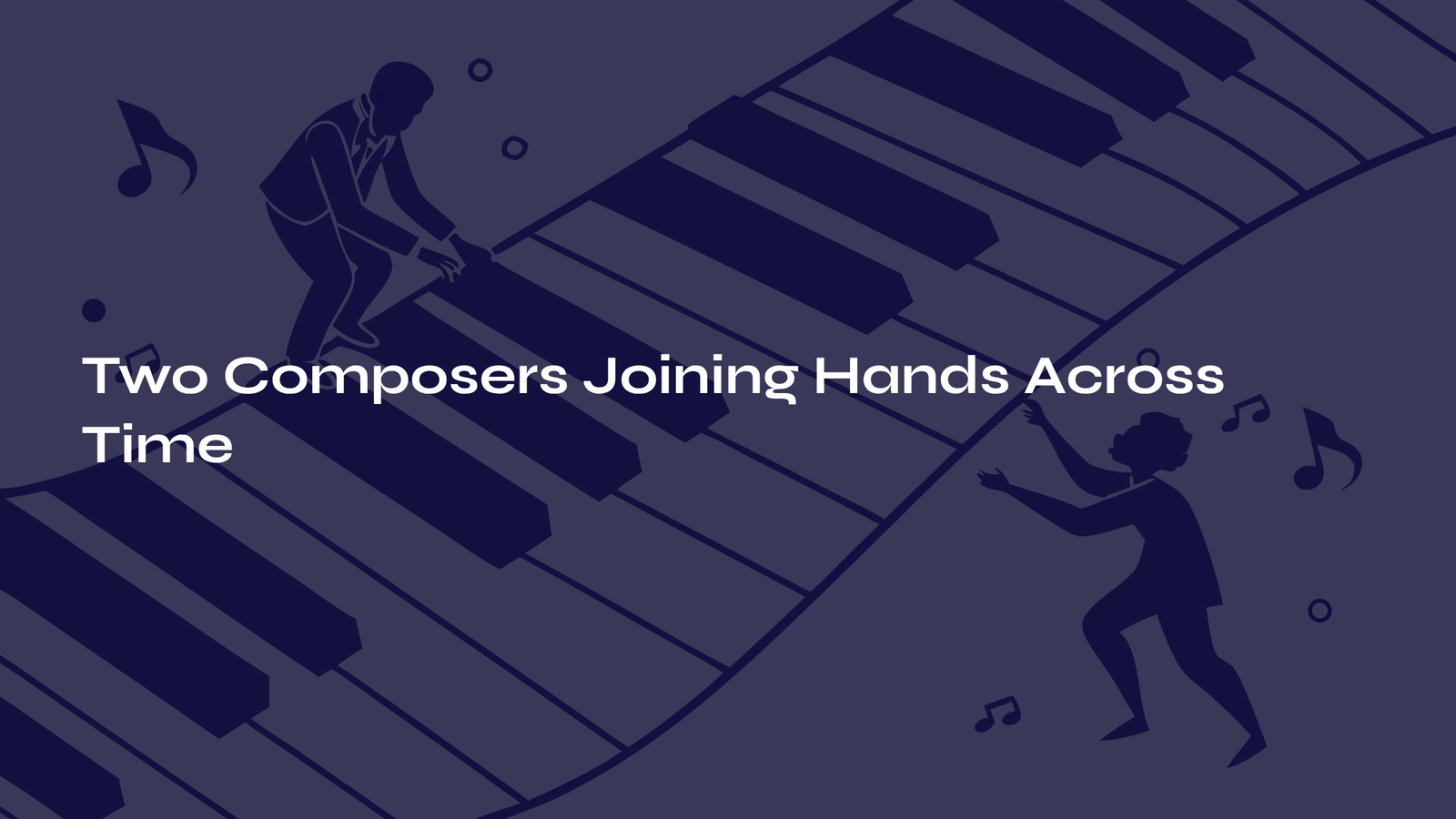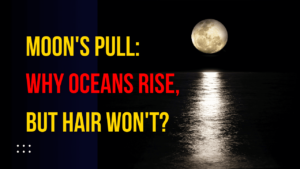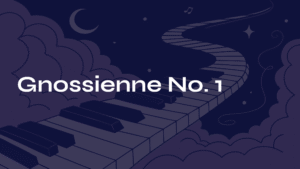Table of Contents
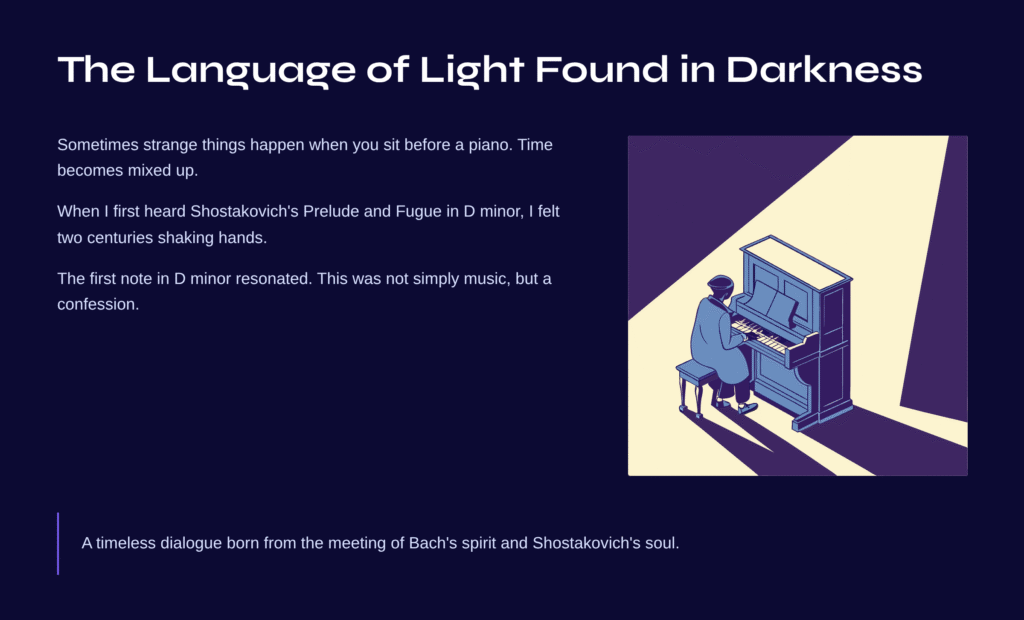
The Language of Light Found in Darkness
Sometimes strange things happen when you sit before a piano. The moment your hands touch the keys, it feels as if time itself becomes mixed up. The story I want to share with you today is about exactly such a moment. When I first heard Shostakovich’s Prelude and Fugue in D minor, I felt as though I was listening to the sound of two centuries shaking hands.
The moment the first note in D minor resonated, I knew. This was not simply music, but a confession. It was the scene of a timeless dialogue born from the meeting of Bach’s spirit and Shostakovich’s soul.
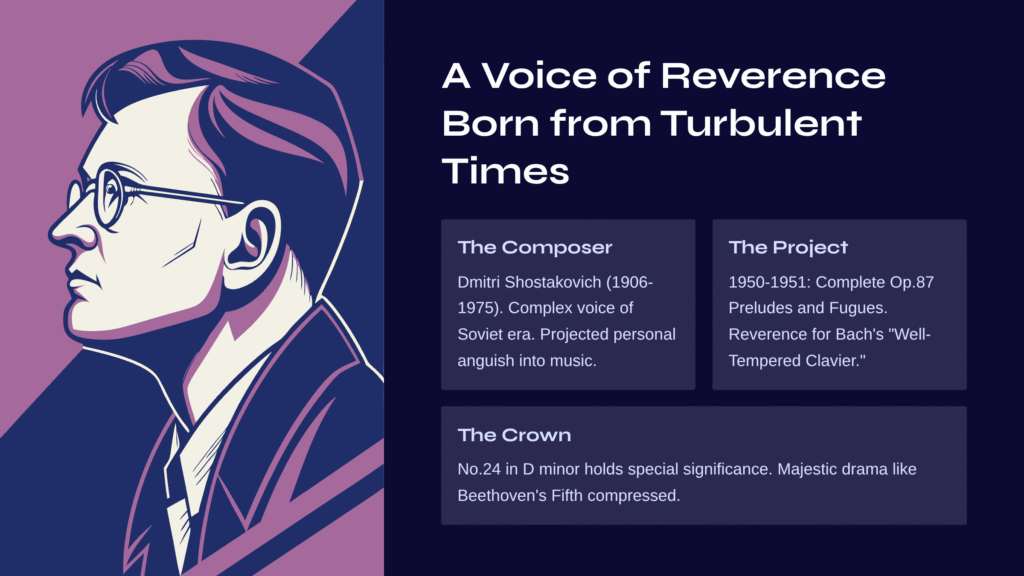
A Voice of Reverence Born from Turbulent Times
Dmitri Shostakovich, born in 1906 and passed away in 1975, was one of the most complex and greatest voices of the Soviet era. He showed exceptional talent in projecting personal anguish and temporal upheaval into his music. Though better known as a symphonic composer, his aspect as a pianist should never be overlooked.
Between 1950 and 1951, Shostakovich immersed himself in a special project: composing the complete Op.87 Preludes and Fugues. This was his expression of reverence for Bach’s “Well-Tempered Clavier.” He paired preludes and fugues in all 24 keys, sending a 20th-century greeting to the Baroque master.
Among these, the final work, No.24 in D minor, holds special significance. This piece, which crowns the series, contains a majestic drama reminiscent of Beethoven’s Fifth Symphony compressed within its structure. Bach’s formal framework holds Shostakovich’s unique passion and lyricism intact.
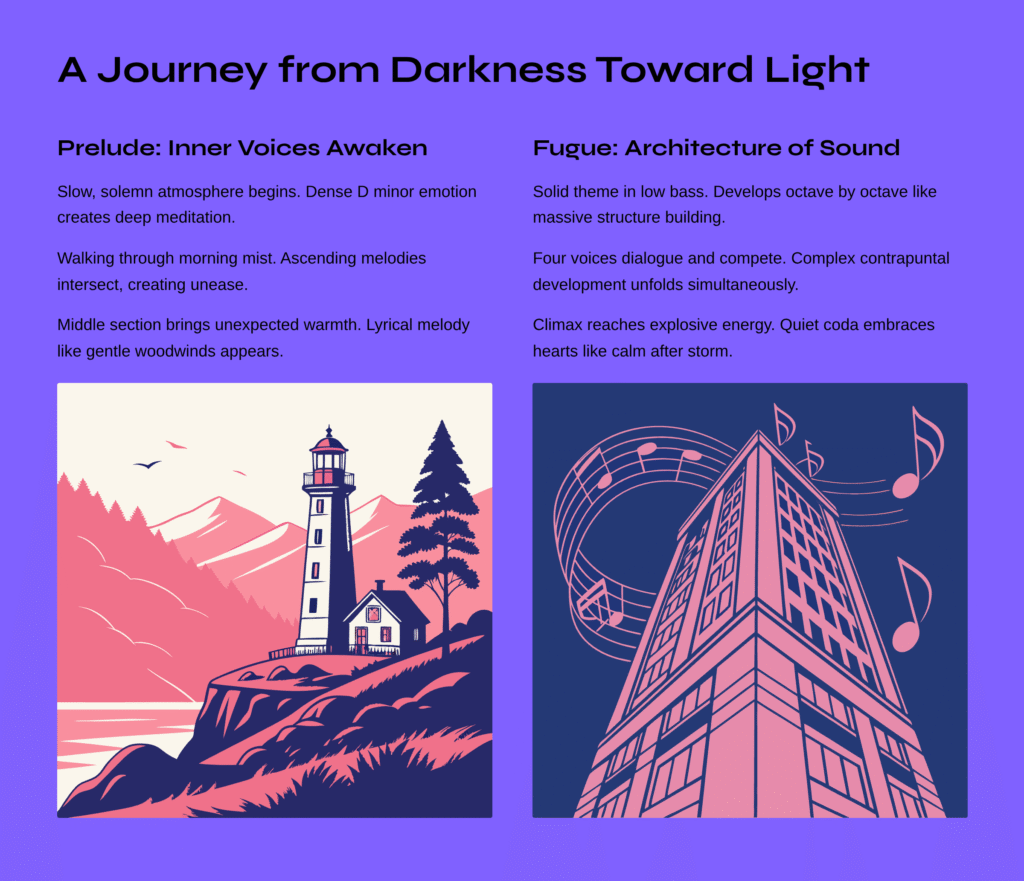
A Journey from Darkness Toward Light
Prelude: The Moment Inner Voices Awaken
The Prelude begins with a slow, solemn atmosphere. The broad introduction, imbued with D minor’s dense emotion, gives the impression of being immersed in deep meditation. Every time I listen to this opening section, I feel as though I’m walking through morning mist. Everything is hazy, yet there’s a sense of searching for something essential within that haziness.
Ascending and descending melodies intersect, creating unease. But this is not destructive anxiety—rather, it’s closer to the trembling felt in the process of moving toward something. And when we reach the middle section, an unexpected moment arrives. A lyrical melody reminiscent of gentle woodwind instruments appears. In this moment, the music conveys warmth like a small candle being lit in the darkness.
Fugue: Building a Palace of Sound Like Architecture
The Fugue begins with a solid theme in the low bass. Watching this theme develop as it ascends octave by octave is like witnessing a massive architectural structure being built layer by layer. While following Bach’s traditional four-voice fugue form, Shostakovich’s unique harmonic language permeates throughout.
The voices dialogue and compete with each other, gradually increasing in density and speed. In this process, complex contrapuntal development unfolds, as if multiple voices are simultaneously telling different stories while creating one grand narrative. When the climax arrives, powerful harmonies and octave pianism reach their peak, releasing explosive energy.
Yet the coda that follows all this passion is surprisingly quiet. The resonant ripples of D minor embrace our hearts like the calm after a storm, bringing the piece to its close.
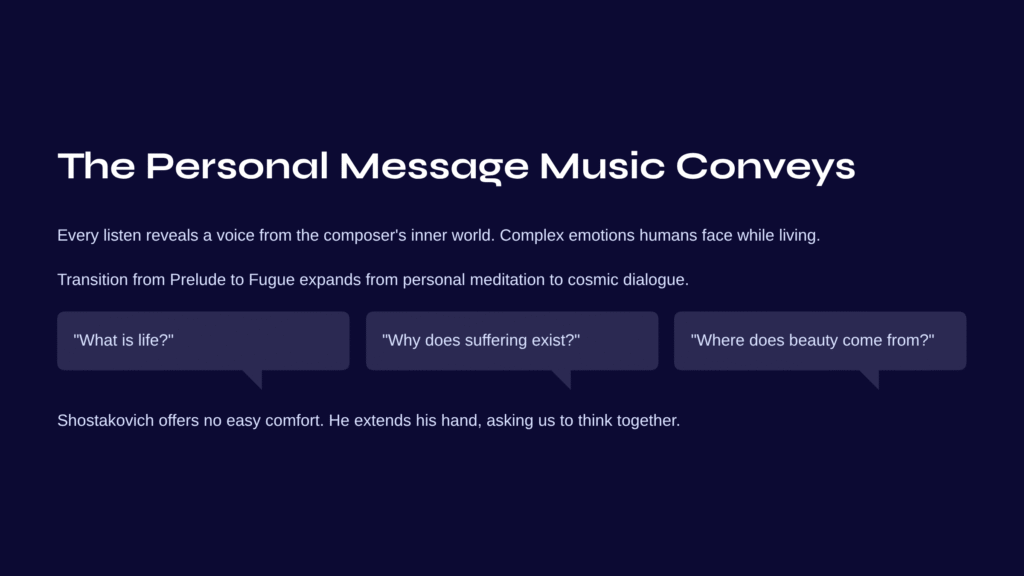
The Personal Message Music Conveys
Every time I listen to this piece, I feel as though I’m hearing a voice from deep within the composer’s inner world. It’s not despair or hope, but something like a complex of all the emotions humans face while living life. In the moment of transition from Prelude to Fugue, I sense an expansion from personal meditation to cosmic dialogue.
Particularly when the fugue’s theme repeats through multiple voices, I feel as though the same questions are being asked and answered from different angles. “What is life?” “Why does suffering exist?” “Where does beauty come from?” It seems like fundamental questions are being explored in music’s language.
And the answers are never simple. Shostakovich doesn’t offer easy comfort or hasty solutions. Instead, he extends his hand to us, asking us to think together, to walk together through life’s complex maze.
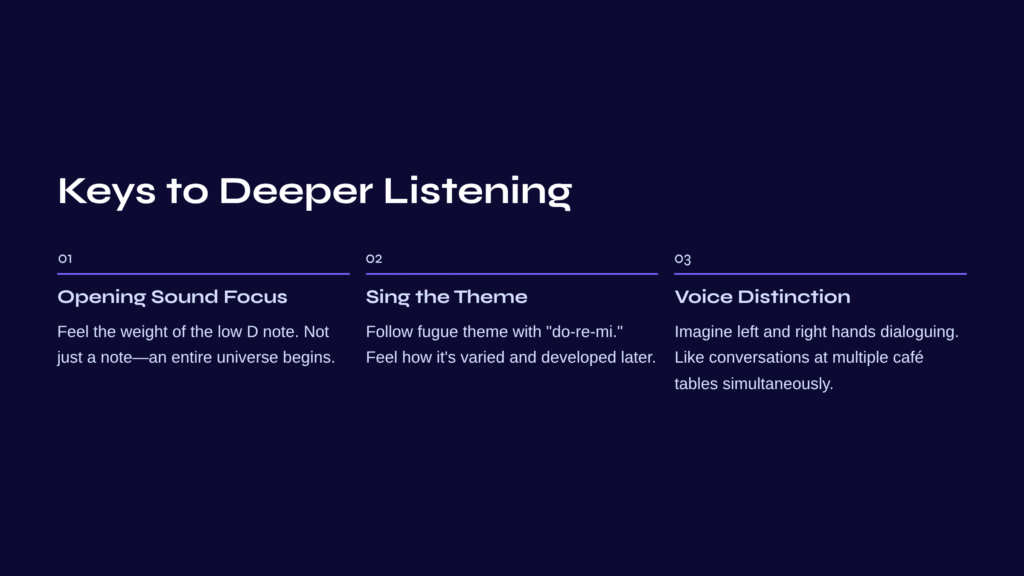
Keys to Deeper Listening
I’d like to offer some practical tips for those encountering this piece for the first time.
First, focus on the opening sound of the Prelude’s introduction. Feel the weight that the low D note carries with your whole being. It’s not just a simple note, but the moment when an entire universe begins.
Second, try singing along with the fugue theme. When the first theme appears, lightly follow the notes with “do-re-mi…” and keep your ears open. This way, you’ll be able to feel much more vividly how that theme is varied and developed later.
Third is distinguishing the voices in the counterpoint. Imagine how the left hand and right hand, each voice part, dialogue with each other like small conversations, and you’ll make very interesting discoveries. It’s similar to listening to conversations at multiple tables in a café simultaneously.
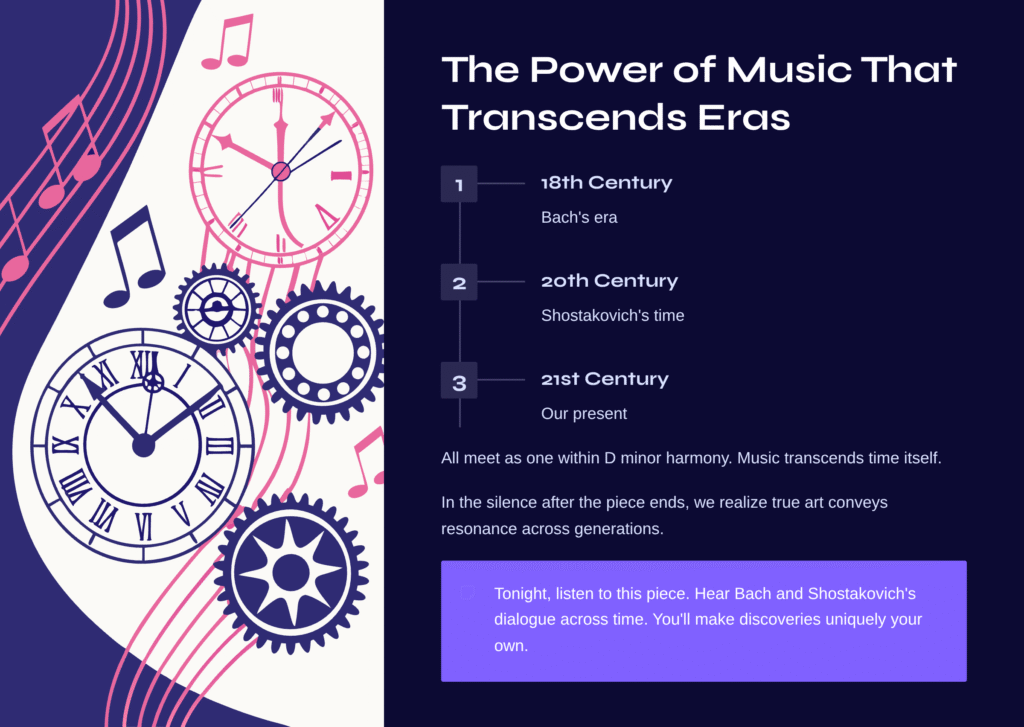
The Power of Music That Transcends Eras
Ultimately, the greatest message this piece conveys is that music transcends time. Bach’s 18th century, Shostakovich’s 20th century, and our 21st century meet as one within this D minor harmony.
In the silence that comes after the Prelude and Fugue end, we realize that music is not simply something that fills time, but something that transcends time. And that true art can convey resonance to the depths of our hearts across generations.
Tonight, if time permits, please listen to this piece. And listen to that dialogue Bach and Shostakovich share across time. You’ll surely make discoveries that are uniquely your own.
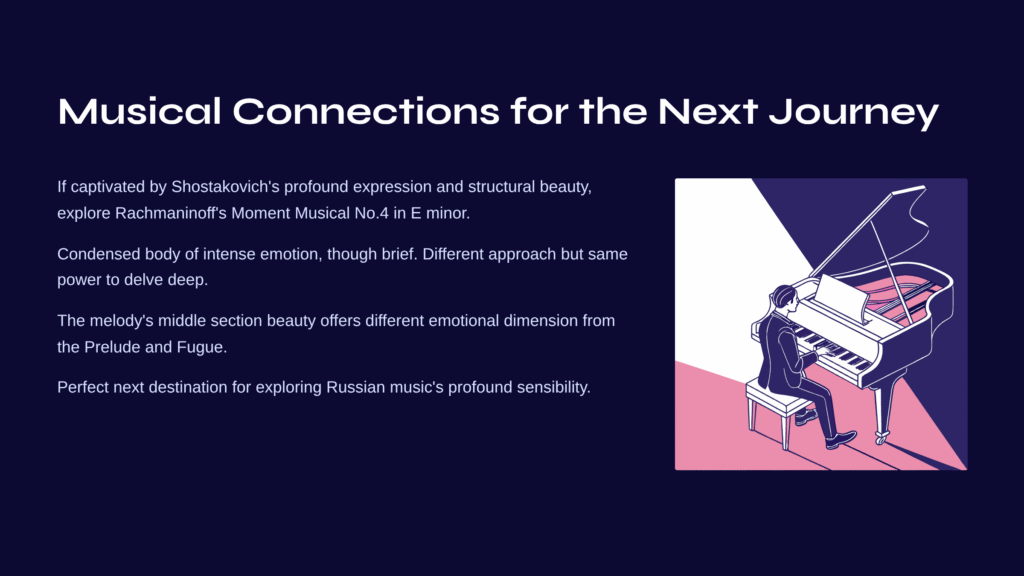
Musical Connections for the Next Journey
If you were captivated by Shostakovich’s profound emotional expression and intricate structural beauty, I recommend Rachmaninoff’s Moment Musical No.4 in E minor.
Rachmaninoff’s Moment Musical No.4 in E minor is a work like a condensed body of intense emotion, though brief. While different in approach from Shostakovich’s intellectual structural beauty, it possesses the same power to delve deep into the human inner world. Particularly, the beauty of the melody that unfolds in this piece’s middle section will offer a different dimension of emotion from the lyricism felt in the Prelude and Fugue.
If you wish to explore more deeply the roots of the profound sensibility that Russian music possesses, this piece would be the perfect next destination.
